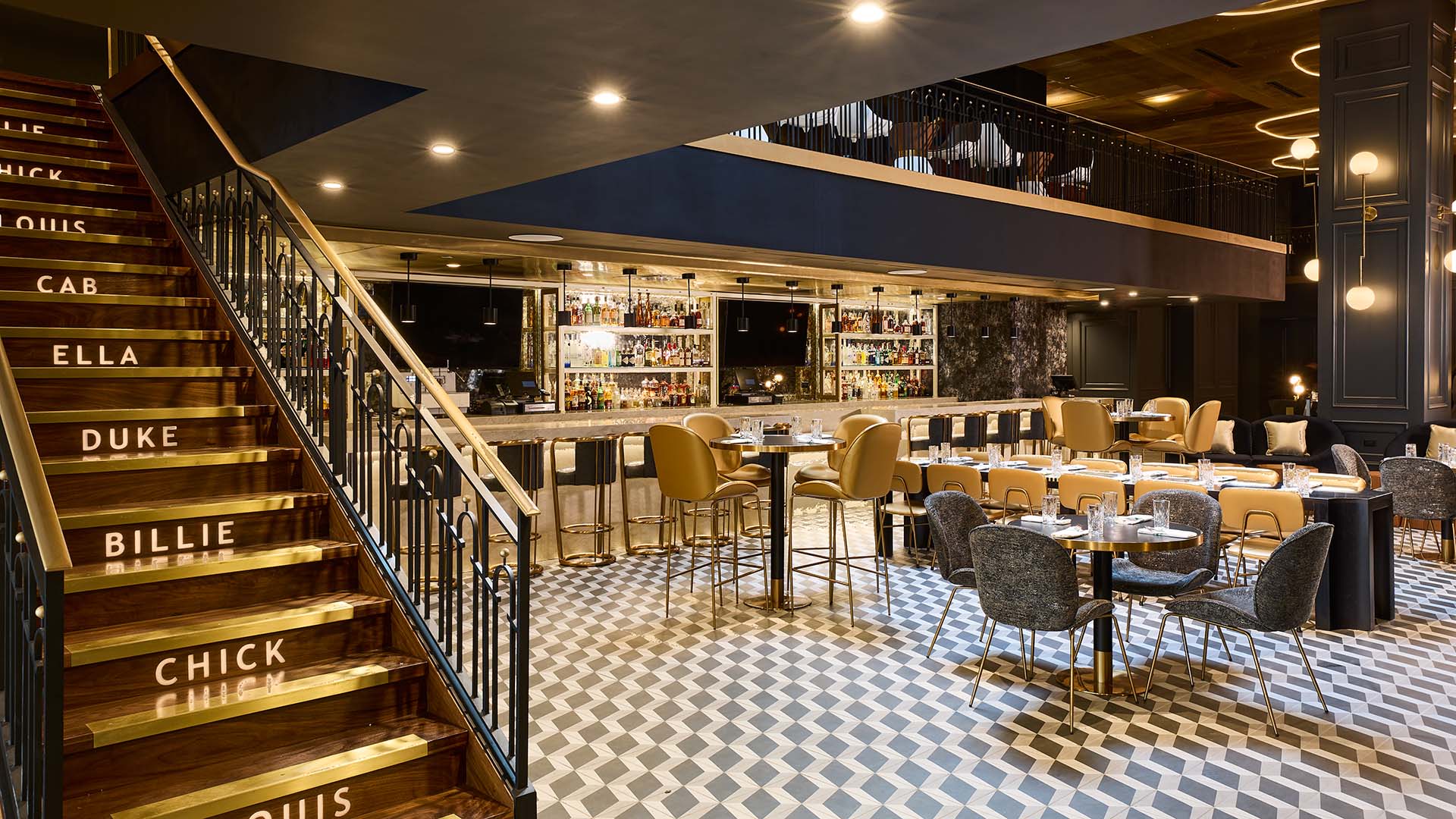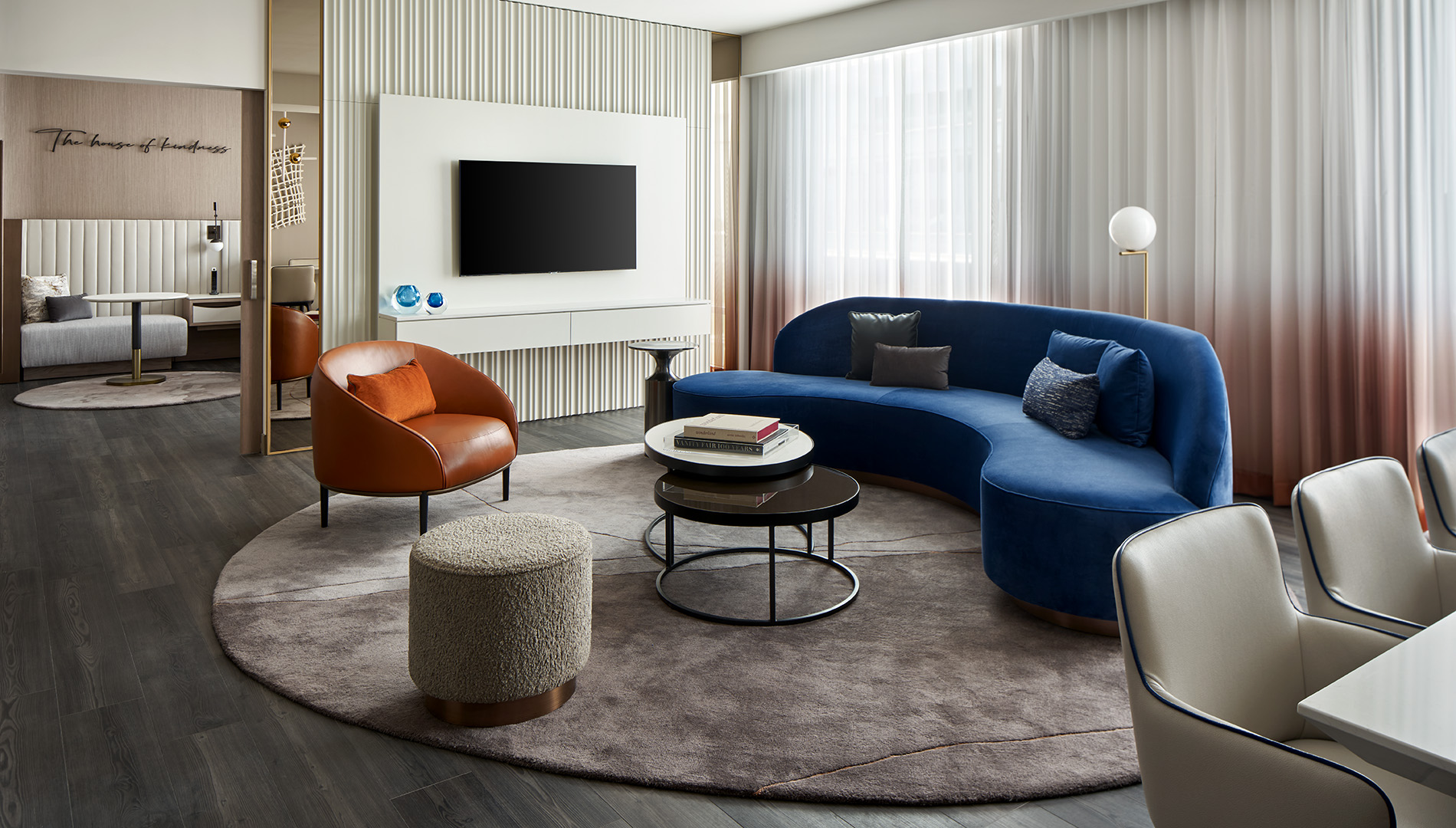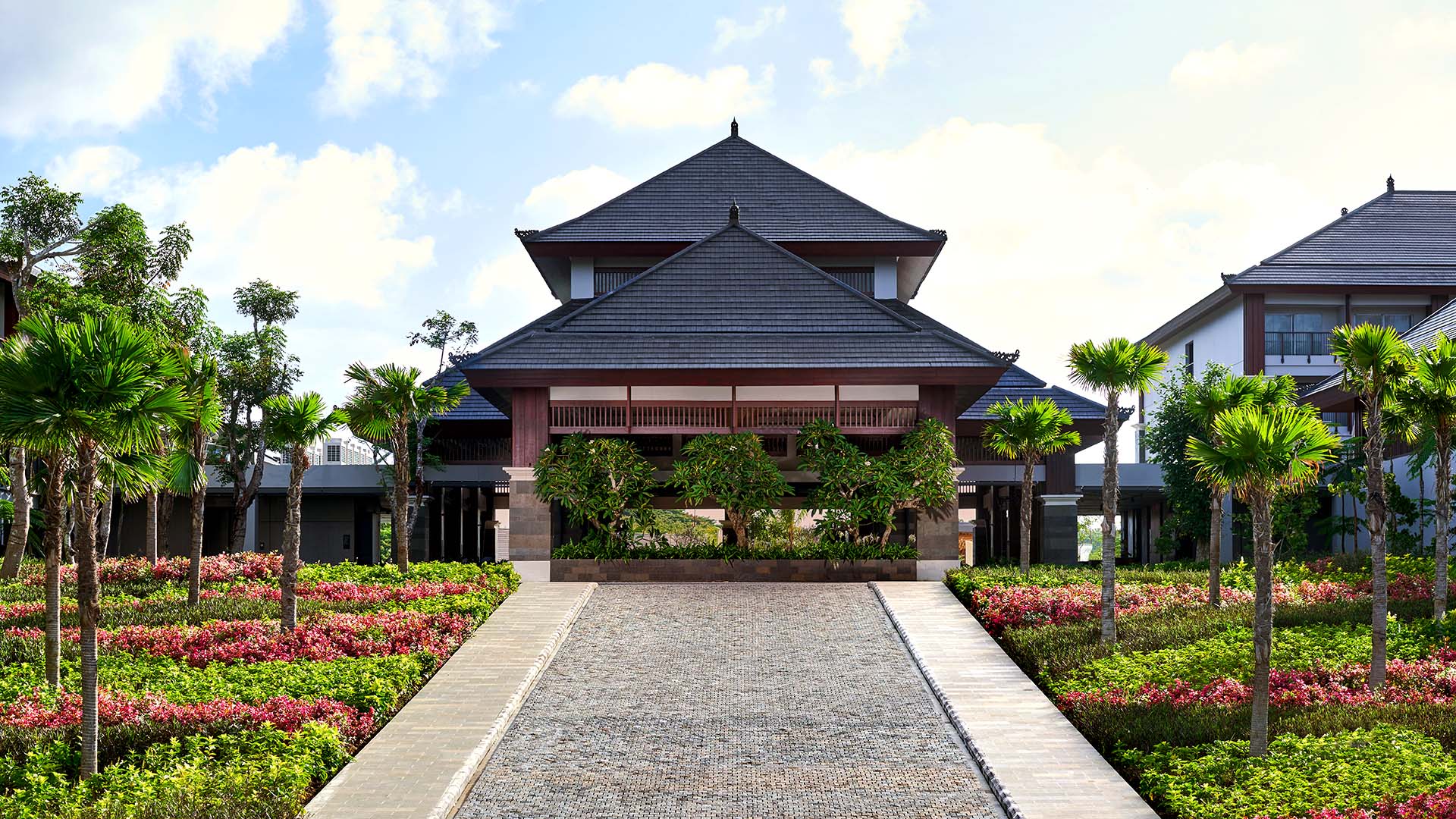
The Renaissance Bali Nusa Dua Resort (Photo: Marriott International)
Travel by DesignExplore Balinese Culture at Renaissance Bali Nusa Dua Resort in Indonesia
By Hamish KilburnOn the southern tip of the Indonesian island of Bali, the Nusa Dua peninsula offers travelers some of the most stunning beaches in Southeast Asia. But the area surrounding Nusa Dua is also home to majestic cliffs, lush hills, and stone temples. These settings offer a chance to connect with Bali’s local landscape, architecture, and culture — an experience that goes beyond a beach-side getaway.
The Renaissance Bali Nusa Dua Resort, secluded from the hustle and bustle of beach-side hotels, makes good on that offer by paying homage to Balinese architecture. The resort is nestled into the hills like a villa, with traditional pitched roofs perched around a courtyard of peaceful walking paths and walled gardens. And the interiors showcase designer Carl Almeida’s deep appreciation for Balinese theater and dance, which he’s cultivated by visiting the island over the course of 18 years.
In this episode, Carl shares a formative travel experience of his — seeing the Whirling Dervishes perform at a historic site near New Delhi — which inspired him to give travelers an experience rooted in culture. From emulating the use of traditional charcoal lava stone to designing rooms based on Balinese dances, he explains how he meticulously crafted this resort to help guests connect with Balinese culture. And at the end of their conversation, he offers Hamish a local travel tip to make his next trip to Bali unforgettable.
- 01:52 – How a life-changing experience with dance in India shaped Carl’s mission as a designer
- 03:50 – What does Bali have to offer beyond a wonderful time at the beach?
- 06:09 – How did Carl draw on Balinese dance to give travelers a connection with Balinese culture?
- 11:18 – When visiting Nusa Dua, where exactly should travelers go to have a life-changing cultural experience, like Carl did?
Featured Hotel: Renaissance Bali Nusa Dua Resort
Featured Designer: Carl Almeida, P49 Deesign
Explore more stories about hotel design at Travel by Design
Follow host Hamish Kilburn’s hotel design reviews @HotelDesigns and global travels @hotel_travel_editor
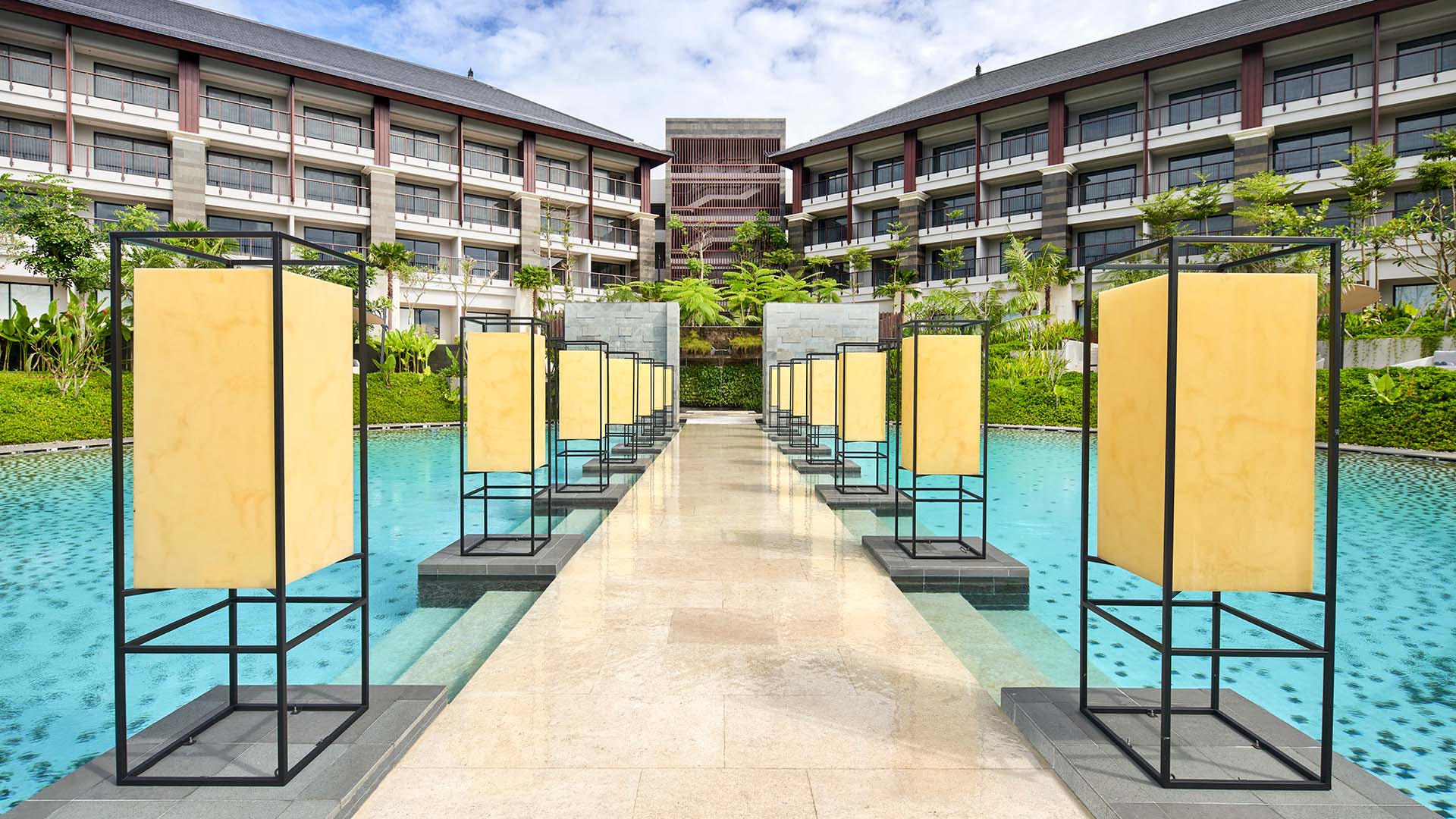
SCRIPT
Cold Open
Carl Almeida: I want to give them a more cultural experience.
It’s not an expected location, when people come to Bali. The original expectation is: “I’m on a beach, I’ve got access to sand, surf, beautiful palm trees…”
And we felt that the highlight of a trip to Bali is the culture, the people.
MUX Begins — “Encore” by Sarah, the Illstrumentalist
And so we chose to do something that was strong in personality and strong reflection of the culture.
Show Open
HAMISH VO: This is Travel by Design — where we chat with the visionaries behind the world’s most extraordinary hotels.
I’m your host, Hamish Kilburn, professional hotel reviewer and the editor of Hotel Designs.
Today, our destination is the Nusa Dua peninsula, which sits on the southernmost tip of Bali, Indonesia.
Bali is the perfect destination for a tropical island getaway.
But Renaissance Bali Nusa Dua Resort — is not like the big beachside resorts that I’m used to seeing in Southeast Asia.
To get there, you actually head away from the coast, towards the hills, and make your way through a small Balinese village. Then, just beyond, you come upon immaculate, triangular roofs emerging from an idyllic walled garden.
There’s a calm, grounded vibe here, a kind of identity I can sense immediately — but without a deeper knowledge of Bali, it’s really not something I can explain. So I spoke with the designer, Carl Almeida, to find out how this resort came to feel so different from other resorts on the island.
Carl Almeida: I’m managing partner here at P49 interior design company based in Bangkok, and we’re probably one of the foremost companies in this part of the world.
HAMISH VO: Carl’s been to Bali many, many times. He was born in India, grew up in Australia, and he’s been living in Bangkok, Thailand for over a decade.
MUX Ends
Act 1: The Power of blending experience, culture, and location
Carl Almeida: I think one of the things that I’ve realized, you know, quite a long time ago is the value of experience.
Hamish Kilburn: Mmm.
Carl Almeida: I think making experiences is what we try to do in all our projects, to create things that are memorable…
It’s something I felt maybe more than 25 years ago, I was with my family, on a trip in India. And before I was really doing major hotels.
If you know, New Delhi, New Delhi has got a lot of monuments, a lot of the history.
We went to see a concert, and the location of the concert was at a monument that was in a state of ruin. So it had that kind of degradation kind of quality to it, that had a sense of history about it.
That was amazing enough on its own, to be honest.
But then the concert that we went to see was a concert based on the dance of the whirling dervishes, and the whirling dervishes are these dancers that, uh, basically just spin around in their flowing outfits, and they just spinning for, you know, for 30, 40 minutes, continuously.
And it’s so hypnotic, so spiritual, just, you know, that aspect of them.
But you mix that with the location, and… it’s just something that’s in my head today, and it gives me chills when I even think about it at this minute.
And I think it set the grounds for me to have that… feeling, where I would love to bring this kind of feeling into wherever possible, where we do design.
Hamish Kilburn: So, Carl, I’ve, I’ve traveled to Southeast Asia and, uh, as I’m speaking to you, I’m, I’m kind of kicking myself that I haven’t quite made it to Bali, so when I’m making my next trip, I’m going to make sure that obviously Bali is absolutely on the list.
But could you tell me and our listeners something about Bali that you might not expect, or it might not be obvious, you know, more than just sort of spending time at the beach, what is it that really sort of grabs people to Bali and really sort of captures their imagination while you’re there?
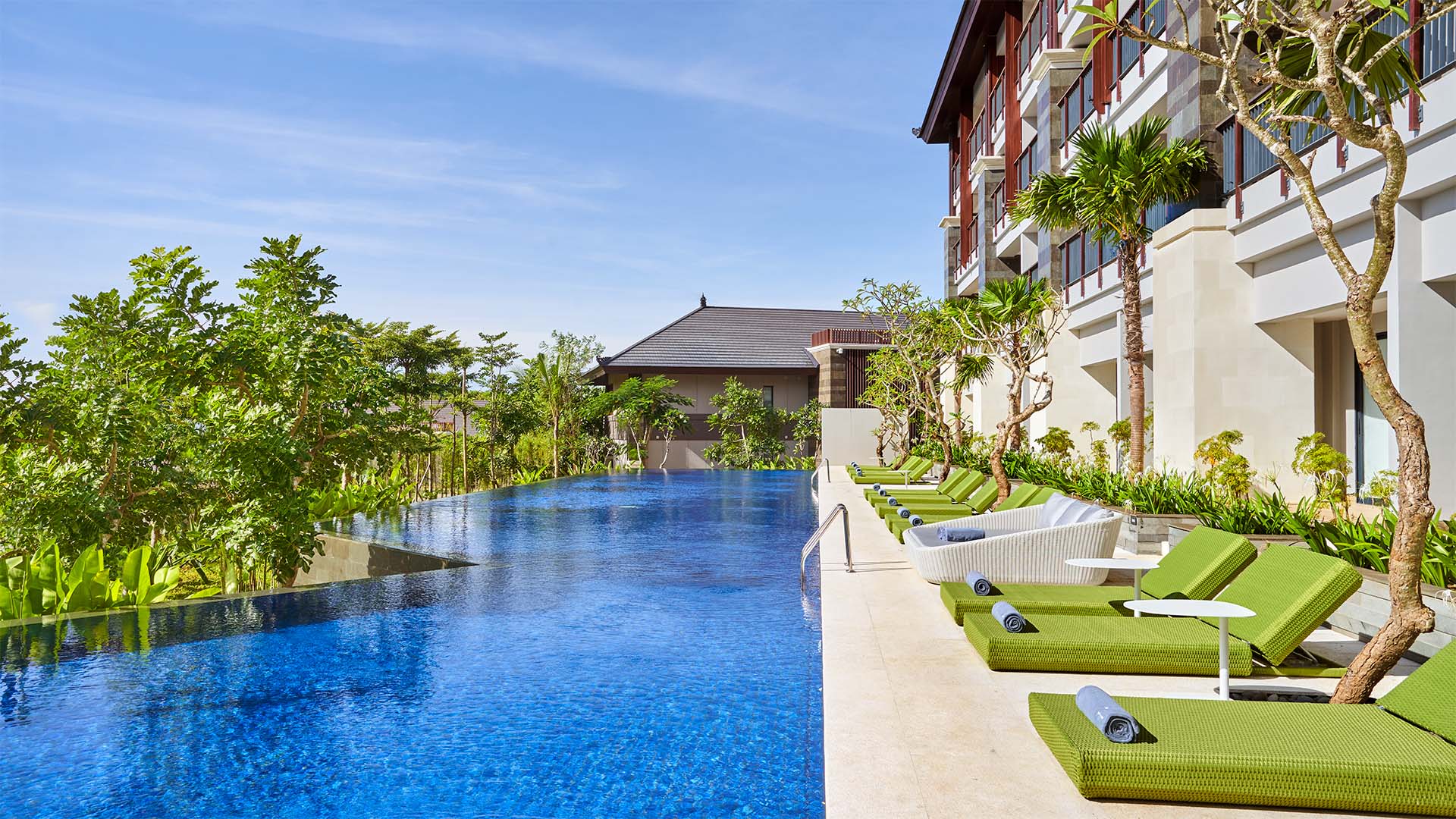
Carl Almeida: Uh, I’ve been working in Bali for almost, I think 18 years.
It’s kind of something that kind of just grows on you, but.. the first time I arrived in Bali, what hit me was the sense of Balinese architecture, of Balinese homes. The amazing carvings they have on their buildings.
Many of their buildings use this local Balinese stone. It’s like a lava stone. It’s charcoal color. And so you have these buildings, and many of them are actually temples that are totally charcoal, almost black.
It has this very mysterious quality about them; my hair is actually standing when I talk about it.
And you know, the climate has a lot of rain. And so these charcoal stones, they have moss that attaches to them, so you get this charcoal-y green buildings. You know, there’s nowhere else like it.
Hamish Kilburn: Yeah, that’s exactly what I notice when looking at, uh, Renaissance Nusa Dua, is, it really fits in with its location, so I was really struck personally by how it looks like a peaceful village sort of tucked in the hills.
Um, visually the buildings have multi tiered pitched roofs, and the way they’re arranged kind of creates this series of hidden courtyards and, and walled gardens.
Um, I think it’s really refreshing that you’re not just dropping the more sort of tropical high rise resorts in, into Bali, you know?
Carl Almeida: Exactly. I think, you know, the architecture, when they started before us, I think they were very conscious of Balinese design, Balinese architecture, and the principles of openness, of ventilation, of strong bases that give formality and strength to spaces, and use of their ability as great craftsmen to have carvings in wood, in stone, so…
I mentioned a while ago that, you know, a lot of the materials used in Balinese design are this charcoal lava stone. So the architecture of all these buildings uses a charcoal stone as a reference to the traditional stone used in the temples.
So these are all things that really resonate. Because it’s really an interpretation of the traditional values, but in a contemporary way, but still clear enough to know that you’re unmistakably in Bali.
Hamish Kilburn: And, and you can tell it’s been sensitively designed to the location and the surrounding area as well. It’s just, it really feels right that it’s there, I think.
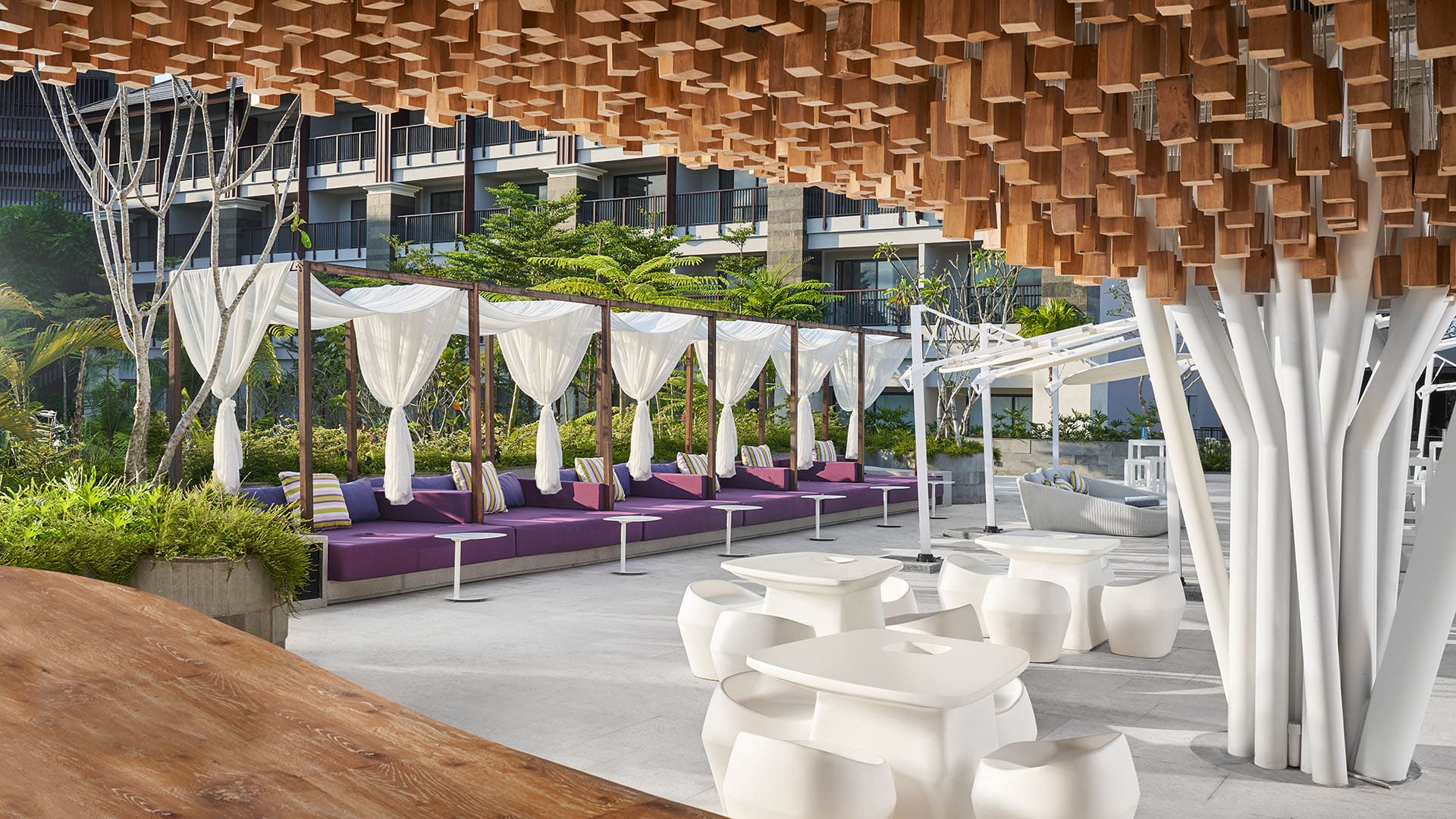
Act 2: Translating Balinese dance to interior designs
Hamish Kilburn: Um, so when you sat down to design the resort, what was the goal?
What do you hope people feel?
Carl Almeida: I want to give them a more cultural experience.
It’s not an expected location, when people come to Bali. The original expectation is: “I’m on a beach, I’ve got access to sand, surf, beautiful palm trees…”
Renaissance Nusa Dua is not on that kind of location. You know, we’re a kilometer or two away from the sea, we’re high on a hill.
And we felt that the highlight of a trip to Bali is the culture, the people.
Hamish Kilburn: It’s really allowing them to be deeper into the experience, as well. That’s, that’s perfect.
Carl Almeida: That’s the reason. It’s because we turned…
What people could see as a negative, we took that, turned it on its head, and said, “Hang on. We’ve got a positive. No other hotel does this. We are so strong into our culture, that you want to come here.
Hamish Kilburn: Yeah.
Carl Almeida: So we took this opportunity to create a narrative based on Balinese dance and theater.
Hamish Kilburn: Mmm.
Carl Almeida: And so as you progress through the different spaces, we focus on different aspects of Balinese dance.
In fact, you know, there’s so many different, uh, dances and dramas and genres in Balinese culture, from shadow theater to chanting to mask dramas, uh, to dance operas, so we had so much to choose from.
Going back to our lobby space, one of the dances that we discovered through our research was a dance called the Pendet.
It’s a welcoming dance, and at the end of the dance, they actually throw flower petals over the guests to welcome you.
But we’ve interpreted that in how we use lighting effects. So we can shine lights and then they kind of flicker on the walls, off the ceiling, and that creates the effect that it’s, it feels like petals falling down, so —
Hamish Kilburn: Oh, wow.
Carl Almeida: It was really a way of interpreting the movement of dance in a very contemporary way; nothing’s literal in this project. But it’s symbolic.
And so, you know, you get this kind of design experience, but it’s deeply rooted in a cultural significance.
Hamish Kilburn: Yeah, and it’s, it’s always there as well, I guess.
With the performance it starts and ends, but with the design it’s kind of always in the lobby.
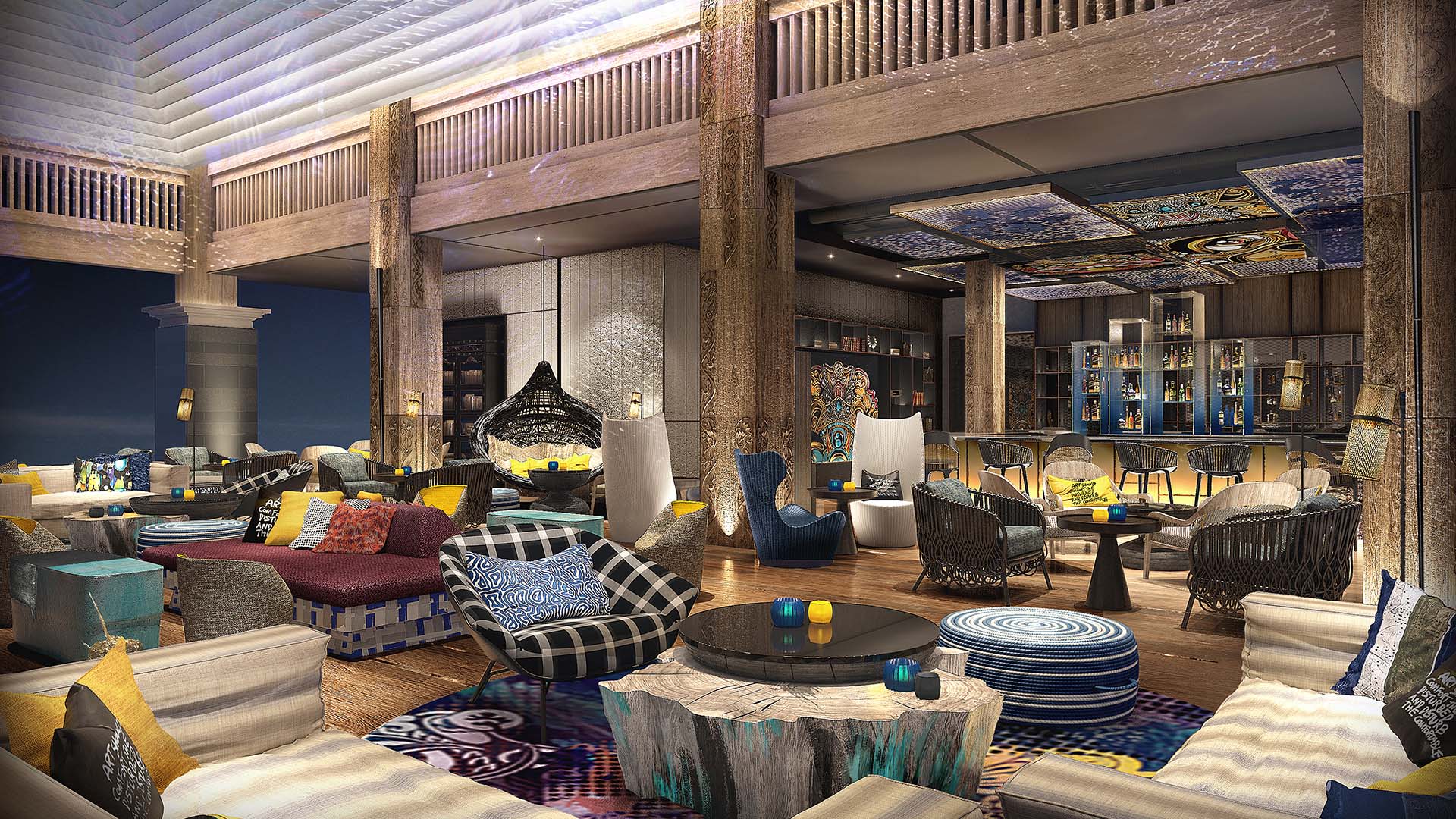
Carl Almeida: It’s always there, and then when we go to the R Bar, which is the bar next to the, the lobby, that’s another type of dance.
Hamish Kilburn: When we’re talking about the R Bar, it’s a really powerful space. I mean, it has the big wooden pillars with the intricate carvings…
It feels traditional, but then you’ve got the furniture and the rugs and the ceiling panels and the modern color palette that feels distinctly contemporary, so I’d love to know what went into the making of this contrast, because it’s… you know, it’s really striking.
Carl Almeida: One of the dances that had a great kind of synergy with the R Bar was something called the Barong.
The Barong is essentially like a lion-like creature, and it’s essentially an eternal battle between good versus evil.
Hamish Kilburn: Oh, okay.
Carl Almeida: That’s the essential principle of the Barong dance.
Hamish Kilburn: And also, like, it’s a great way to play with the juxtapositions between traditional and contemporary, I guess, with the dance as well that reflects the design scheme.
Carl Almeida: Exactly. You know, where we’ve got traditional carvings on one side, if you look at the ceiling, it turns itself into metal panels, which has still got the carvings of the headgear that the Balinese dancers use.
But then we’ve interlinked that with LED screens. So you get this total contradiction of modern material and modern kind of presentation within the LED.
Hamish Kilburn: But interestingly, it’s, it’s all connected. Which I think is really wonderful, actually, how, how you kind of piece that together.
Carl Almeida: Well, I think we were lucky in the sense that through the architecture, the main lobby space had incredibly high ceilings. You know, I think it’s more than 15 meters tall.
But then when we get to the R Bar, to help you feel more cozy, the ceilings are about three and a half meters. So you get the feeling that you’re within a different space, even though it’s directly adjacent the main lobby space, so…
You feel different from one space to the other, even though you’re exactly side by side, just through the use of volumetric design.
Hamish Kilburn: Mm, mm, and I love that, when you walk into a bar and you almost feel kind of hugged by the architecture, and you don’t really know why, it’s a subconscious feeling that you have of feeling calm and in a different space.
Carl Almeida: Yeah. So, different spaces have different needs. When you’re in some spaces, you want to be overpowered. But when you’re in a space where you want to maybe talk quietly or even talk loudly, you might want to be more cozy.
So, yeah, you can create, through design, different experiences by using height, as an example, materiality, as an example…
You can use different design strategies to make people feel comfortable. And at the end of the day, no matter what we do, we’re trying to make people feel something.
Hamish Kilburn: Absolutely. So I love all things movement, when I travel, I want to really kind of connect with the space, and I feel like that theme, and that idea of dance, will allow people to kind of feel like they can move, I guess, with the space, you know? (Laughs)
Carl Almeida: (Chuckles) Yes.
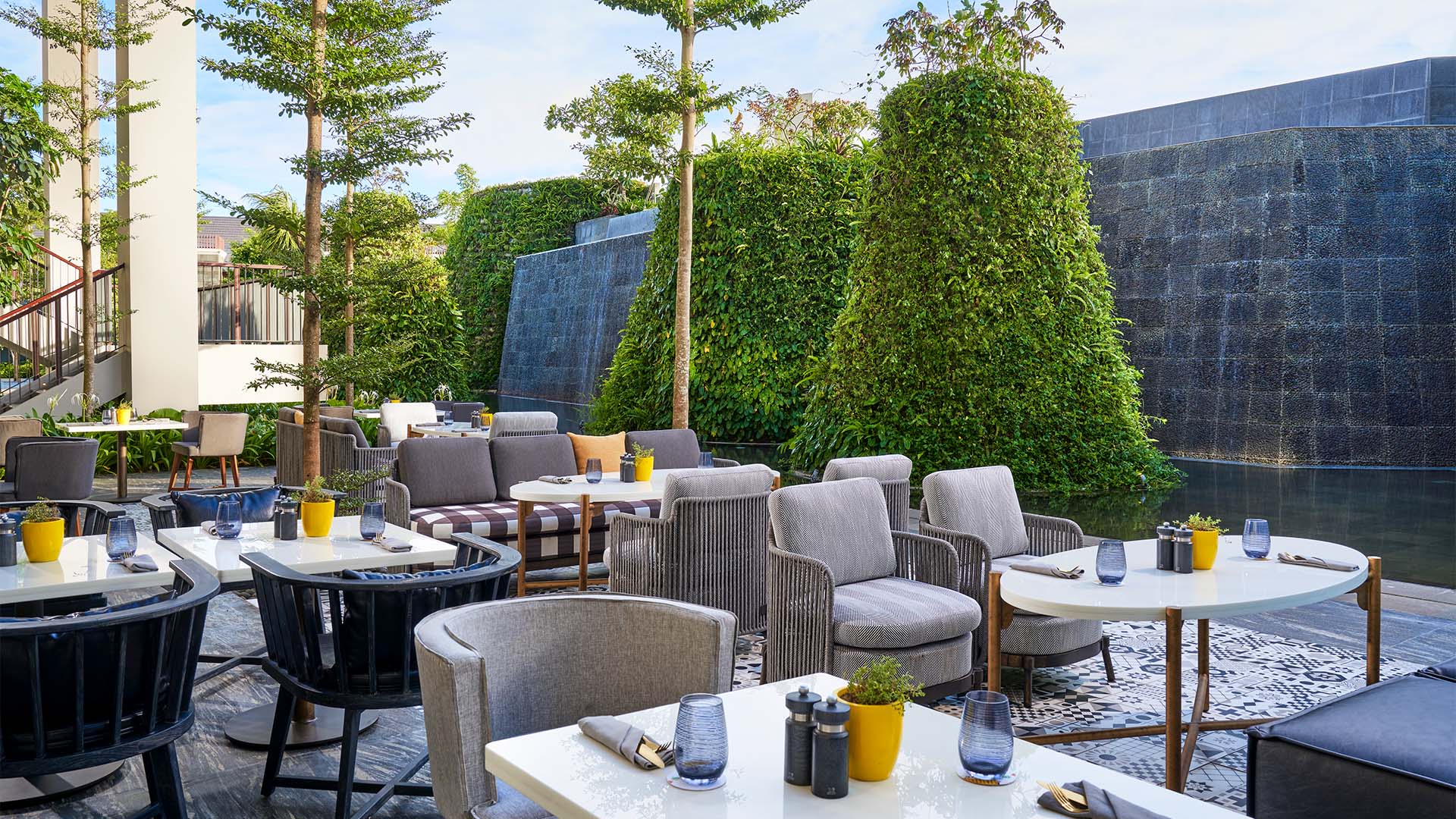
Act 3: Where to connect with Balinese culture in Nusa Dua
Hamish Kilburn: Um, I’m kind of interested from travelers going to Bali, who maybe they haven’t had that kind of life changing experience yet, where’s a really good place to go and visit and sort of really feel part of the location? Outside of the hotel, perhaps?
Carl Almeida: There’s so many things that I would recommend you do, uh, in Bali —
Hamish Kilburn: It sounds like you can’t have enough time in Bali.
Carl Almeida: There’s not enough time. I still, there’s so much I want to do.
I think what I would love to tell people is that if you want an experience, if you want to be moved, you need to go to Uluwatu.
Uluwatu is about 45 minutes from Nusa Dua. And Uluwatu Temple itself is about a thousand years old.
It’s on the top of a cliff high above the ocean, and you’ve got the amazing sea in front of you.
And it’s even more special at sunset because Bali has amazing sunsets.
And then on top of that, you’ve got this incredible performance called the Kecak fire dance.
Uh, they all form in a circle. And then they start chanting. And then it’s just a series of feelings that encompasses you, because you’re being hit by sound, by vision, by even smell ’cause there’s fire around the dance…
And if that’s, if that’s not a memorable experience, nothing is! So if you want to be moved, go to the Uluwatu Temple and see this Kecak dance.
Hamish Kilburn: I can imagine as well, when you’ve gone to the temple, and you come back to the hotel, maybe you appreciate the design elements a bit more, because obviously, with it being inspired around dance, you must maybe sort of feel the space differently? I don’t know.
Carl Almeida: You’re actually totally right. I think once you see the real culture, the real temple, the real carvings, you’ll then start to appreciate what we did a lot more, and you’ll realize, “Now I get it.”
Hamish Kilburn: Yeah.
Carl Almeida: You know, because the way we’ve done it is not an obvious, obvious way. But once you know it, you’ll really appreciate it more.
Hamish Kilburn: I think that’s the gift of travel, isn’t it? When you can really connect with people, and local people, and culture. So to go and see a dance in this setting, that just sounds breathtaking, really.
Carl Almeida: Yeah, it’s, it’s got everything put together. The location, the culture, the people, it’s all coming together in one venue, so it’s a highlight.
Hamish Kilburn: Yeah, totally.
Carl. I honestly can’t imagine a better person to talk me through and to show me and to sort of really experience Bali.
I’m obviously a lover of how design can be used to really kind of draw out these narratives, so, it’s just refreshing.
So thank you so much for being here and your time and your energy, it’s been wonderful. Thank you.
MUX Begins — ”Overlander” by Steven Gutheinz
Carl Almeida: Thank you so much, Hamish. It’s been really great to talk to you, I’ve enjoyed the experience, and… word of advice: You have to go to Bali.
Hamish Kilburn: Well, when I am there, I’m going to be giving you a call, and you can show me around.
Carl Almeida: Give me a call, give me a call, and I’ll show you around for sure.
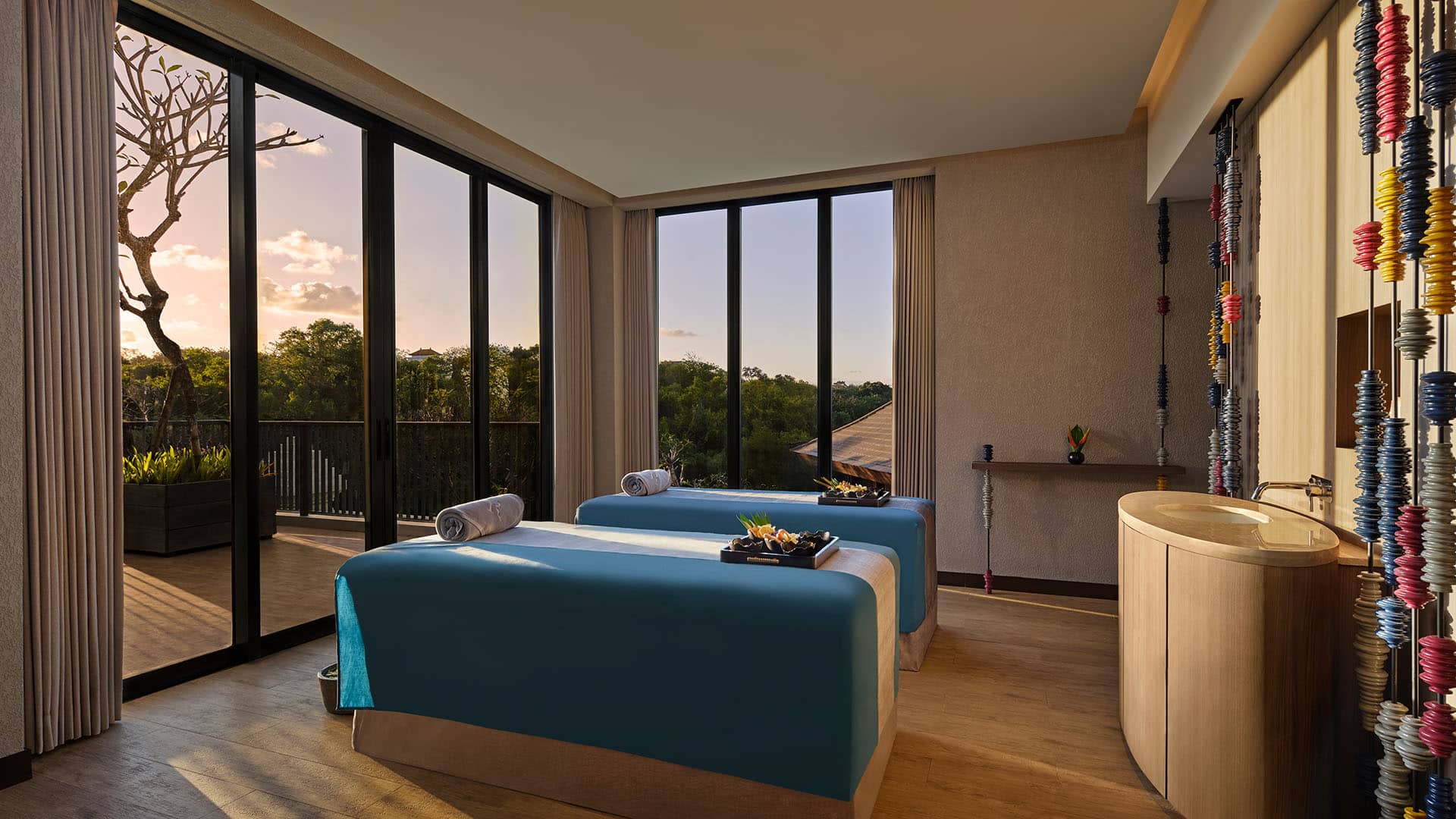
Credits
HAMISH VO: Travel by Design is a podcast by Marriott Bonvoy Traveler, the online travel magazine where you’ll find more inspiring hotel design stories.
If you’re curious about the craft of hotel design, then check out marriottbonvoy.com/travelbydesign.
And if you want to go behind the scenes of my travel experiences across the world, then follow me on Instagram @hotel_travel_editor.
This episode was produced by Narratively Creative. Our Senior Producer is James Boo. Our Associate Producers are Nidhi Shastri and Greta Stromquist.
Interview recording by Dew Napattaloong.
Story edits by Priscilla Alabi, sound design by James Boo, and audio engineering by Dorian Love.
Our Marriott Bonvoy Traveler producers are Valerie Conners and Robin Bennefield.
Special thanks to Carl Almeida for speaking with me about his work.
I’m your host, Hamish Kilburn. Don’t forget to subscribe to Travel by Design wherever you get your podcasts. And tune in next time to hear more design stories behind the world’s most extraordinary hotels.







